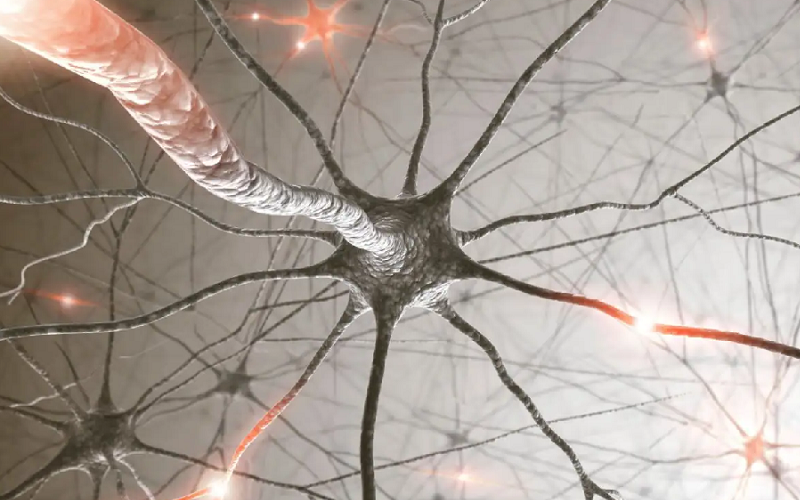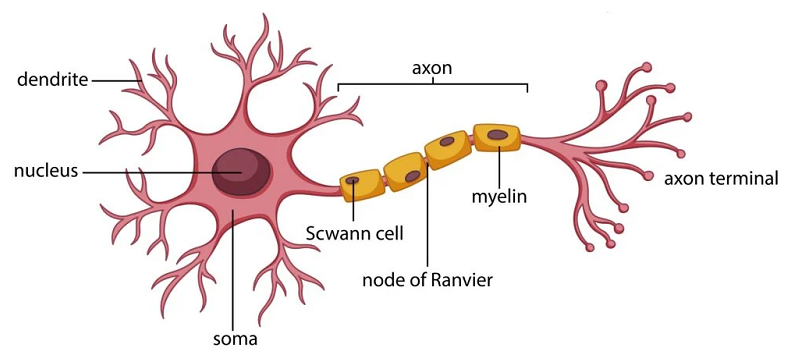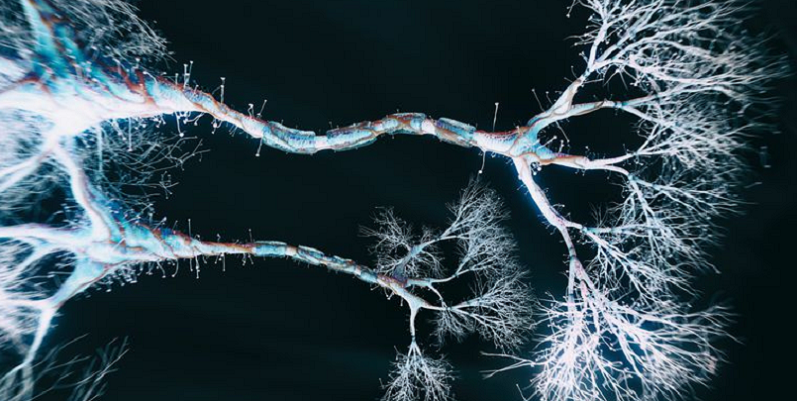
Often hailed as the building blocks of the brain, neurons are much more than mere brain cells; they are the architects of our thoughts, emotions, and actions. But what really are these microscopic marvels? Are they confined only to our brains, or do they weave their magic elsewhere in our bodies? Can these nerve cells regenerate, adapt, or even multiply? Here we take you through the fundamentals of neurons — from their unique characteristics as brain cells to their role as nerve cells conducting electrical impulses.
Contents
- Understanding Neurons: The Basics
- Neurons Beyond the Brain: A Wider Perspective
- Neurons as Brain Cells: Their Unique Characteristics
- Neurons as Nerve Cells: The Electrical Impulse Conductors
- Regeneration and Growth: The Adaptability of Neurons
- The Limitations of Neuronal Replication
- Neuronal Distribution: Where Neurons Are Located
- References
Understanding Neurons: The Basics
Neurons are the core components of the nervous system, including the brain, spinal cord, and peripheral nerves. They are specialized cells responsible for transmitting information throughout the body.
Definition of Neurons
Neurons, often referred to as nerve cells, are the primary cells of the nervous system. Their main function is to process and transmit information, which they achieve through electrical and chemical signals. Unlike other cells in the body, neurons have a unique structure comprising a cell body, dendrites, and an axon. The cell body contains the nucleus and cytoplasm, dendrites receive incoming signals, and the axon transmits signals to other cells.
Neurons as the Fundamental Units of the Brain
Serving as the fundamental units of the brain and the entire nervous system, neurons play a pivotal role in the processing and conveying of information. They are responsible for everything from our sensory experiences to the control of muscle movements. The brain contains approximately 86 billion neurons, each forming connections with thousands of other neurons, creating an incredibly complex and dynamic network.
The Role of Neurons in the Nervous System
Neurons function within the nervous system by transmitting information between different areas of the brain, and between the brain and the rest of the body. This communication is essential for everything we do, think, and feel. There are several types of neurons, including sensory neurons, motor neurons, and interneurons, each with a specific function in processing and transmitting information.
Neurons Beyond the Brain: A Wider Perspective
While neurons are predominantly associated with the brain, their influence extends far beyond. Here we explore the presence and role of neurons outside the brain, offering a broader understanding of these vital cells.
Are Neurons Only in the Brain?
Contrary to common belief, neurons are not exclusive to the brain. They are also abundantly present in the spinal cord and throughout the peripheral nervous system. This widespread distribution allows neurons to perform a variety of functions beyond brain activity, such as controlling muscle movements and relaying sensory information from the external environment to the brain [1].
Neurons in the Peripheral Nervous System
The peripheral nervous system, comprising nerves outside the brain and spinal cord, is teeming with neurons. These peripheral neurons play crucial roles in motor functions, sensory reception, and autonomic processes that maintain bodily functions like heart rate and digestion. They act as the communication line between the brain and the rest of the body, ensuring coordinated and responsive actions.
The Connective Role of Neurons Throughout the Body
Neurons serve as the body’s communication network. Sensory neurons transmit information from sensory receptors to the brain, enabling perception of stimuli like heat, cold, and pain. Motor neurons, on the other hand, carry commands from the brain to the muscles, facilitating movement. This interconnectivity underscores the importance of neurons not just in brain function but in the overall operation of the human body.

Neurons as Brain Cells: Their Unique Characteristics
Neurons, while a fundamental part of the overall nervous system, hold a special place in the brain. Here we explore the unique characteristics of neurons as brain cells, distinguishing them from other cell types and highlighting their significance in brain function.
Are Neurons Brain Cells?
Indeed, neurons are a key type of brain cell. Unlike other cells in the body, neurons specialize in transmitting information through electrical and chemical signals. They form an extensive network within the brain, allowing for complex processes like thought, memory, and emotion. This specialization is what sets neurons apart from other cells in the brain, such as glial cells, which provide support and protection for neurons [2].
Distinct Features of Neurons in the Brain
Neurons in the brain have distinct features that enable them to perform their critical functions. They possess a high degree of plasticity, meaning they can change their connections and strength of connections over time. This plasticity is essential for learning and memory. Additionally, the unique structure of neurons, with dendrites and axons, allows them to create a vast network of connections, forming the basis of our cognitive abilities.
How Neurons Differ From Other Brain Cells
While neurons are the most celebrated cells in the brain due to their signaling capabilities, it’s important to understand how they differ from other brain cells. Glial cells, for instance, outnumber neurons and play roles in nutrient transport, waste removal, and structural support. These cells do not transmit information like neurons but are essential for maintaining the health and function of neurons.
Neurons as Nerve Cells: The Electrical Impulse Conductors
While we have explored neurons in the context of the brain, it is equally important to understand their role as nerve cells. Neurons are renowned for their ability to conduct electrical impulses, a key aspect of their function as nerve cells.
Are Neurons Nerve Cells?
Yes, neurons are indeed nerve cells. They are the primary type of cell found in the nervous system and are specialized for the task of transmitting information. This transmission occurs through electrical impulses and chemical signals, a process that is fundamental to all neural activities, from reflexes to complex thought processes [3].
The Electrical Nature of Neuronal Communication
The electrical nature of neuronal communication is a fascinating aspect of neurobiology. Neurons communicate by generating electrical signals known as action potentials. These are rapid changes in the neuron’s membrane potential that occur when the neuron is stimulated. This electrical activity is what allows neurons to quickly transmit signals over long distances within the body.
The Role of Neurons in Transmitting Information
Neurons play a critical role in transmitting information throughout the nervous system. This is achieved through a combination of electrical impulses (action potentials) and chemical signals (neurotransmitters). When an action potential reaches the end of a neuron, it triggers the release of neurotransmitters, which then cross the synaptic gap to the next neuron. This process is how neurons communicate and is integral to every aspect of our physical and mental functioning.

Regeneration and Growth: The Adaptability of Neurons
One of the most intriguing aspects of neurons is their ability (or inability) to regenerate and grow. Here we get into the current scientific understanding of neuronal regeneration and neuroplasticity, providing insight into the adaptability and limitations of these vital cells.
Can Neurons Regenerate?
The ability of neurons to regenerate has been a subject of significant scientific inquiry. Unlike many other cells in the body, mature neurons in the human brain generally do not regenerate after injury. However, research has shown some capacity for regeneration, particularly in the peripheral nervous system. This has led to ongoing research into how to stimulate or enhance this capability in the central nervous system.
The Current Understanding of Neuronal Regeneration
Current understanding suggests that while central nervous system neurons have a limited ability to regenerate, there is some potential for repair and regrowth, particularly in the context of neuroplasticity. Neuroplasticity refers to the brain’s ability to reorganize itself by forming new neural connections throughout life. This ability is crucial for learning, memory, and recovery from brain injuries [4].
Do Neurons Grow Back? Exploring Neuroplasticity
The question of whether neurons can grow back is closely tied to the concept of neuroplasticity. While neurons in the adult brain generally do not grow back in the same way as cells in other parts of the body, the brain can reorganize its functioning and reroute tasks through new neural pathways. This remarkable adaptability allows for a degree of recovery and adaptation following neural damage, offering a promising avenue for therapies aimed at neurodegenerative diseases and brain injuries.
The Limitations of Neuronal Replication
An important aspect of understanding neurons involves recognizing their limitations, particularly in terms of replication and division.
Can Neurons Divide?
One of the defining characteristics of neurons is their inability to undergo cell division, especially in the mature human brain. Unlike other cells in the body that can replicate through cell division, most neurons are post-mitotic, meaning they do not divide after they are fully formed. This inability to divide after maturing is a fundamental aspect of neuronal biology.
Why Neurons Differ From Other Cells in Division
The reasons why neurons cannot divide like other cells are complex and multifaceted. One primary reason is that the highly specialized nature of neurons makes the process of division and replication more challenging. Neurons form intricate networks through their dendrites and axons, and replicating these complex connections accurately during cell division would be extraordinarily difficult. Additionally, the stability of these networks is crucial for maintaining long-term functions like memory and learned skills.
Research on Neuronal Birth and Death
Despite their inability to divide, neurons do have a life cycle that includes birth (neurogenesis) and death (apoptosis). Neurogenesis occurs mostly during prenatal development and in certain brain regions in adulthood, like the hippocampus. Understanding the processes of neuronal birth and death is crucial for research into neurodegenerative diseases, brain injuries, and the aging process. Scientists continue to explore ways to stimulate neurogenesis and protect neurons from premature death, offering potential pathways for treating various neurological conditions.
Neuronal Distribution: Where Neurons Are Located
Understanding the distribution of neurons is crucial for comprehending how the nervous system functions as a whole. This section sheds light on the various locations of neurons within the human body, emphasizing the diverse environments in which they operate and their specific functions in these locations.
Where Neurons Are Located in the Human Body
Neurons are not just confined to the brain; they are spread throughout the body. They are predominantly found in the brain and spinal cord, which comprise the central nervous system. However, neurons also form an extensive network within the peripheral nervous system. This includes sensory neurons that relay information from sensory organs to the brain and motor neurons that convey commands from the brain to the muscles [5].
The Diverse Environments of Neurons
The environments where neurons operate are incredibly diverse. In the brain, neurons are responsible for higher-order functions like thinking, decision-making, and emotional regulation. In contrast, in the spinal cord, neurons are crucial for reflex actions and transmitting messages between the brain and the rest of the body. Peripheral neurons, located outside the brain and spinal cord, are involved in sensing environmental stimuli and initiating muscle contractions.
How Neuron Location Affects Function
The location of a neuron greatly influences its function. Neurons in the brain, for example, are often involved in complex processing and integration of information, whereas those in the peripheral nervous system are more directly involved in sensory perception and motor responses. Understanding the specific roles of neurons in different parts of the body is key to understanding how the nervous system orchestrates a wide range of human activities, from simple reflexes to complex cognitive processes.
References
[1] All you need to know about neurons
[2] What is a neuron?
[3] Introduction to Neurons and Neuronal Networks
[4] How Do Neurons Work?
[5] Brain Anatomy and How the Brain Works

